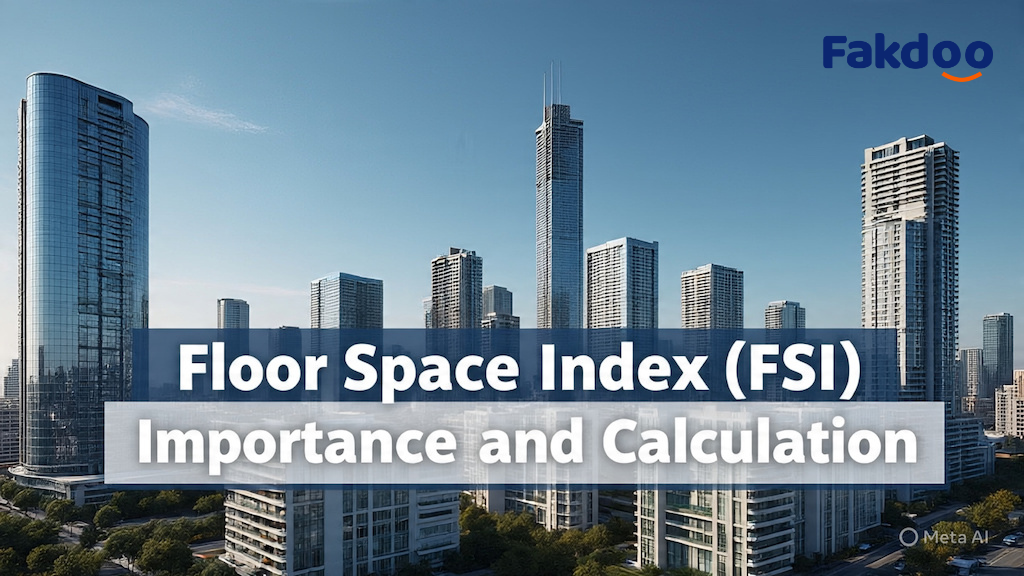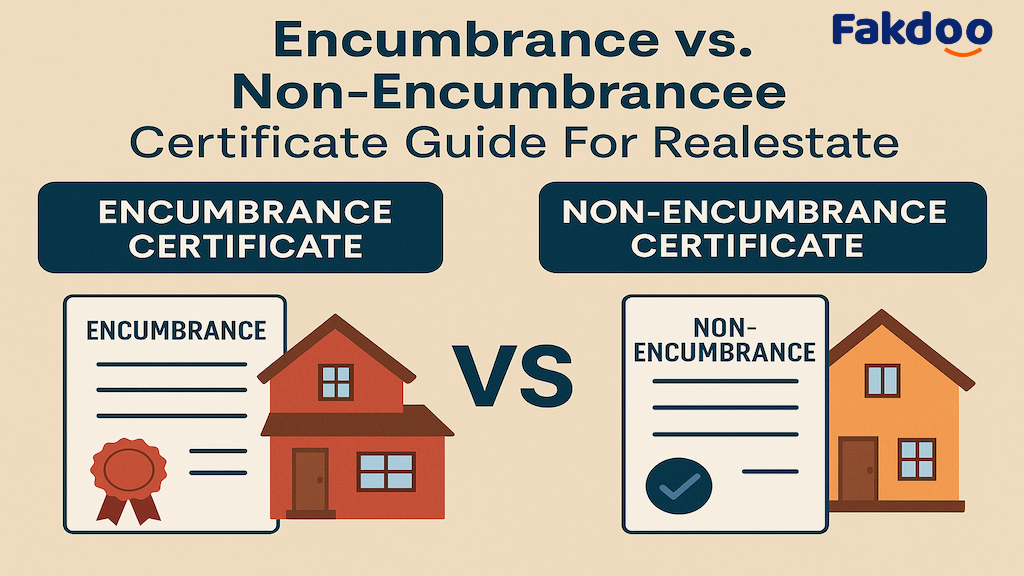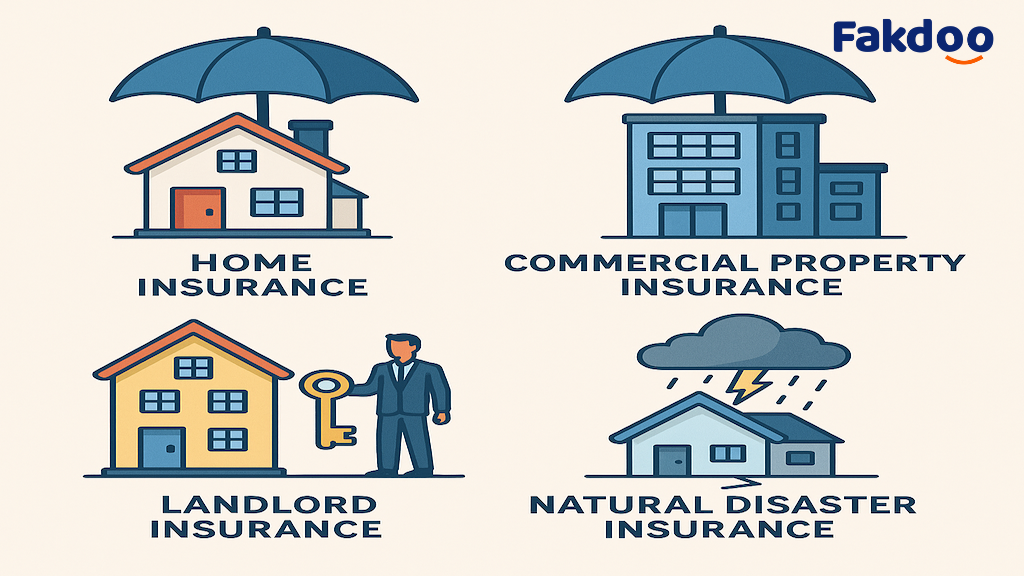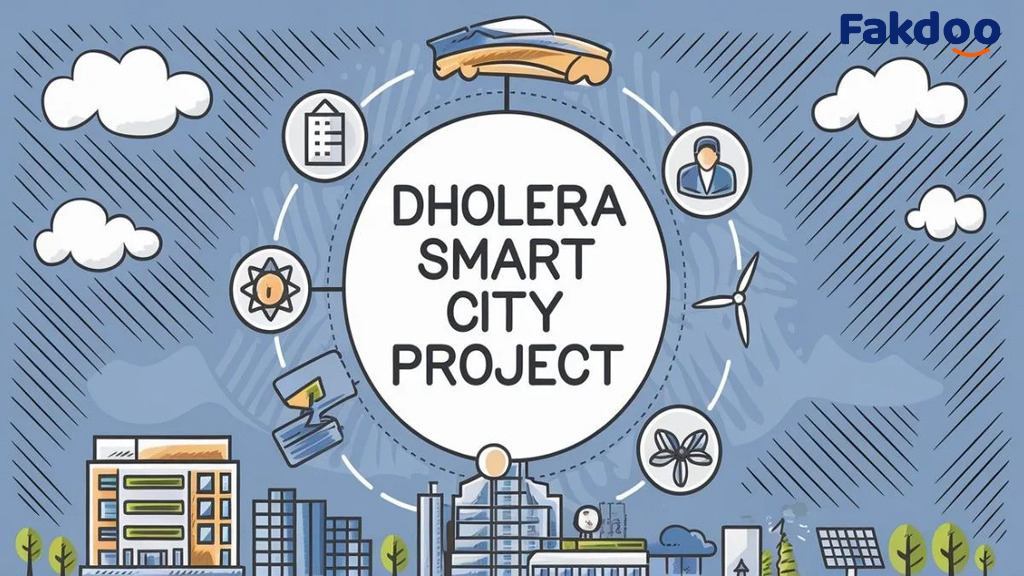What is Power of Attorney in Gujarat-A Complete Guide
Your Legal Empowerment with POA in Gujarat
Your Legal Empowerment with POA in Gujarat

In financial and legal affairs, many times one needs to provide authority to someone to act on their behalf. A Power of Attorney (POA) is the solution for this. Whether you are purchasing property, dealing with finances, or taking care of personal matters, a Power of Attorney can make these processes much simpler.
In Gujarat, like everywhere else in India, POA is a statutory document that vests certain powers in a person (referred to as the Attorney-in-Fact or Agent) to act on behalf of another individual (referred to as the Principal). In this blog post, we'll discuss all you need to know about Power of Attorney in Gujarat — the forms, procedure, and law.
What is a Power of Attorney (POA)?
A Power of Attorney (POA) is an official document where the principal grants permission to another individual (the agent or attorney-in-fact) to represent him or her in certain legal or financial transactions. It is most commonly utilized when the principal cannot act on his or her own because he or she is ill, absent, or lacks experience.
The Attorney-in-Fact can either be vested with general powers or limited powers based on the situation required by the principal.
Types of Power of Attorney in Gujarat
In Gujarat, according to Indian law, there are mainly two types of POAs:
1. General Power of Attorney (GPA)
A General Power of Attorney provides broad powers to the attorney to act on behalf of the principal in nearly any legal issue. Such powers can be for selling property, managing property, dealing with business transactions, or representing the principal in different legal proceedings.
Main Points about GPA:
- The attorney enjoys wide powers.
- Generally utilized in financial transactions, business or property dealings.
- Not restricted by particular actions; deals with most aspects.
2. Special Power of Attorney (SPA)
A Special Power of Attorney provides limited authority to the attorney for a particular purpose or task. The principal outlines the extent of powers, e.g., signing a document, going to court hearings, or effecting a specific transaction.
Important Points regarding SPA:
Limited to defined acts or transactions.
Generally utilized for one-off jobs such as selling a property, purchasing land, or finalizing a legal transaction.
Simpler to cancel than a General Power of Attorney.
Legal Framework for Power of Attorney in Gujarat:
In the state of Gujarat, the Indian Contract Act, 1872 and the Power of Attorney Act, 1882 regulate the usage and validity of Power of Attorney documents. The Registration Act, 1908 is also significant when it relates to registering POAs that are in connection with property transactions.
A POA has to be signed and executed by the principal in front of at least two witnesses. A POA, in case of sale or transfer of property, has to be registered in the local sub-registrar office in Gujarat to make it legally valid.
Steps to Make a Power of Attorney in Gujarat:
Making a Power of Attorney in Gujarat is quite simple. Here's how you can do it:
Step 1: Prepare the POA Document
The POA should be drafted cautiously, mentioning the powers being given to the agent specifically.
The document should include:
- The name and address of the principal,
- The name and address of the agent,
- The particular powers being given (General or Special),
- Duration of the POA (if any),
Clear directions for the agent about how the powers can be utilized:
Step 2: Sign the POA
After the document has been prepared, the principal signs the POA before two witnesses. Both the principal and witnesses should understand the contents of the document before signing.
Step 3: Notarization (if required)
While notarization is not always required, it is strongly advised, particularly for General Power of Attorney. Notarizing a POA guarantees the document is legally verified.
Step 4: Registration (if required)
If the POA concerns property transactions or is a General Power of Attorney, the same is to be registered with the Gujarat sub-registrar's office. To register a POA:
- Both the attorney and the principal need to be present.
- Submit the signed POA document with identification proof.
- Pay the applicable stamp duty (differs depending on the value of the property or transaction).
- The document will be duly registered, and a receipt will be given.
Step 5: Keeping Copies
Once the POA is signed and registered, keep the document with you and leave a copy with the attorney-in-fact. You can also keep the original copy with a trusted friend or lawyer.
When to Apply Power of Attorney in Gujarat:
Power of Attorney can be utilized under a range of circumstances, for instance:
Litigation and Court Representation: A POA has the ability to enable an attorney to represent the principal in court, for example, for filing cases or hearing court proceedings.
Revocation of Power of Attorney
A Power of Attorney can at any time be revoked by the principal if they are mentally fit.
How to revoke a POA in Gujarat:
Key Points to Consider for POA in Gujarat:
Trustworthiness of Agent: The individual that you select as your attorney must be trustworthy because they will become privy to sensitive financial, legal, and personal information.
Duration of the POA: Be specific about the duration of the POA if it's a time-specific assignment. In the case of indefinite or long-term powers, have a provision to cancel the POA as and when required.
Legal Complications: Take note that fraud or abuse of POA may lead to legal action. If at all, constantly track transactions executed under POA.
Conclusion
A Power of Attorney is a vital legal instrument that provides authority to another person to act for you in matters such as property deals, business, and personal choices. Whether you are purchasing property, dealing with assets, or looking after business affairs in Gujarat, a clear and duly registered POA can save you time and energy. Ensure you know the legal effects and seek advice from a legal professional if necessary to make sure the POA is properly carried out.
By adhering to this blog's guidelines, you can easily carry out a Power of Attorney in Gujarat and entrust your duties seamlessly.

One of the most significant factors in real property is Floor Space Index (FSI), also referred to as Floor Area Ratio (FAR). FSI is defined as the total area of land that will be utilized during development. FSI is a ratio of floor area covered out of available land.
The FSI is determined by the local regulatory authorities or bodies, and it is generally determined by the Code of Building. The National Building Code of India generally provides guidelines for building construction.
FSI may be utilized to understand the desirability of the location and the population density.
In addition, comprehending the FSI is crucial, even from an ecological point of view. Since usually there are fewer spaces open if the FSI is high, the homebuyers need to consider this.
Understanding FSI and FAR:
FAR and FSI are the same but stated differently. A FAR is a decimal, while an FSI is a percentage. The FSI may vary from city to city and even within one city from one area to another. Based on the number of stories in the building, FSI may vary even in one location. FSI is regulated by city zone, building type, and other characteristics.
Prior to starting any project, contractors are required to send plans for the proposed building for approval to the respective zone. Such details involve whether the construction will be residential or commercial, how tall and what structure it would be, how big the plot of land on which it would be constructed, etc.
The place is the foremost feature that impacts the FSI directly. The FSI is usually higher in places with metros due to the limited space. But with the vast tract of land available for construction, FSI can be low in rural areas.
Some local government authorities compute higher FSIs based on area of land. Because the road is wide, any plot near one will have an increased FSI. The FSI can be computed through a simple formula using the built-up area and the area of the plot.
Floor Space Index (FSI) Formula
Floor area of all the floors and land plot area are needed to calculate the Floor Area Ratio (FAR) or Floor Space Index (FSI). It can then be estimated by the following:
FAR = Total Floor Area of All Floors of the Building/Plot Area
FSI = Total Floor Area of All Floors of the Building/Plot Area × 100
If FAR is 1, the entire plot area can be utilized as per this parameter. If FAR is less than 1, the land is underdeveloped at several places. Once again, the build-up has more than one story if FAR is more than 1.
Floor Space Index (FSI) Calculation:
Suppose you want to build a 2000-square-foot building on a piece of property which is 1000 square feet. Applying the above formula, then:
=> FAR = 2000 / 1000
=> FAR = 2
In FSI, the value is 200% if the FAR value is 2. This means that they can construct 2000 square feet on a land of 1000 square feet.
In addition, the municipal council considers the road width and other factors when determining the Floor Space Index (FSI) of a certain locality.
Importance of Floor Space Index (FSI)
FSI value determines the value of land in a particular region. Thus, this value determines whether and how much land can be utilized for a building. The FSI value differs from one location to another and is based on the number of stories each building has. Thus it is only fixed over some locations.
he FSI ensures disciplined development in every sector, such as railroad stations, commercial and residential buildings, etc., to meet the schedules, thus rendering city development and planning more standardized. This may assist in marking open areas clearly from construction areas.
No unauthorized development is allowed either.
Affordability also comes into the picture due to the fact that more FSI enables builders to construct more and sell more. This will prove handy in places where houses for all are in dire need. Less FSI implies lesser use of that piece of land for development. If the FSI builds the building, then the builder is not exposed to questions about NOCs.
Pros of Having FSI in Cities:
F.S.I. can be taken as a constraint, though it has benefits in urban areas or some areas where development is progressing very rapidly.
It maintains the ratio of developed to free space constant.
Consequently, it maintains the skyline of the city intact.
A mean value of F.S.I ensures successful development of the project.
Hence, it is important to have balance between development and planned, consistent growth.
Disadvantages of FSI:
F.S.I is considered to be a poor indicator of physical fitness there. This means that the employment of and the concept of housing the ever-growing population face lower values of F.S.I.
Therefore, one has to make an average F.S.I work as a strength and produce a 'product' that deals with all the problems at hand.
ConclusionL:
The highest floor area that can be constructed over a certain plot is calculated using the floor space index, commonly referred to as the floor area ratio. It's calculated from several variables, such as amenities, building type, and city zone classification.
The builder needs to stay within the previously determined government-approved floor space index during construction. The floor space index/area ratio greatly influences the total cost of the building. FSI is impacted by many variables, such as style of the building, size of the lot, place or location, and so on.

When it comes to ownership of property, particularly that of real estate and legal papers, two terms tend to come up: Encumbrance and Non-Encumbrance. As a buyer, seller, or investor, knowing these terms is important in order to prevent legal issues and have a smooth transaction.
In this blog, let us discuss what encumbrance and non-encumbrance are, how important they are, and the most significant differences between the two.
What is an Encumbrance?
An encumbrance is a legal claim, responsibility, or limitation on a property that can be restrictive to its usage or transfer. It implies that the property is not completely free of legal or financial burdens.
Typical Forms of Encumbrances:
Bank or financial institution liens or charges:
Encumbrance Certificate (EC)
- An Encumbrance Certificate is a formal document that the Sub-Registrar's office issues showing all registered financial or legal dealings (sale, mortgage, lease) involving a property within a specified time range.
What is a Non-Encumbrance?
- A non-encumbrance indicates that the property does not have any legal encumbrances, loans, disputes, or restrictions upon it is absolutely free and clear. In other words, it is a "clean title."
- Non-Encumbrance Certificate is not a standalone document but usually a reference to an Encumbrance Certificate indicating "No Encumbrance" for a specific time period. It means the property has not been engaged in any transaction such as a mortgage or lawsuit during that time period.
Why is it Important to Check for Encumbrances?
How to Get an Encumbrance Certificate?
Conclusion:
Whether you are purchasing a house or investing in property, knowing the encumbrance status of a property is imperative. An encumbered property may carry legal baggage, but a non-encumbered property makes you tension-free and ensures hassle-free transfer of ownership.
Always get a recent Encumbrance Certificate prior to any agreement it's a small step that can help avoid big risks in the future.
Pro Tip:
If you find a "Nil Encumbrance" noted in the certificate, it does not necessarily indicate that all is well. Always check with a lawyer or property expert, particularly for big investments.

Whether you're a homeowner, landlord, or business, your property is one of your greatest assets. What if something happens to it, though, and it gets damaged by fire, floods, theft, or acts of nature? That's where property insurance steps in.
Throughout this blog, we'll guide you through what property insurance is, why it's important, the various types out there, and how to select the most appropriate coverage for your needs.
What is Property Insurance?
Property insurance** is a form of insurance that covers your physical property such as your home, office, or rented building against loss or damage due to factors like fire, theft, vandalism, and natural disasters. It helps ensure you don't incur massive financial losses in case your property is destroyed or damaged.
This type of insurance usually protects:
Why is Property Insurance Important?
1. Financial Protection: It covers losses arising from unforeseen damage or theft.
2. Loan Requirement: Insurance is usually required by most banks to grant a home loan.
3. Peace of Mind: Having the knowledge your investment is insured provides emotional security.
4. Disaster Preparedness: Enables quick recovery from floods, earthquakes, or fires.
5. Legal Liability: Pays for legal fees if a person gets harmed on your property.
Types of Property Insurance in India:
1. Home Insurance
2. Commercial Property Insurance
3. Landlord Insurance
- Insures rental properties and covers the structure of the building, possible legal damages, and loss of rent.
4. Renter's/Tenant's Insurance
- Insures personal items in a rented home but not the building itself.
5. Natural Disaster Insurance
What Does Property Insurance Usually Cover?
NOTE: Coverage may differ based on the insurer and policy type. Always check the fine print.
What's Not Covered? (Common Exclusions)
* Intentional damage
* Wear and tear
* War or nuclear risks
* Poor maintenance
* Damage caused by pests (e.g., termites, rodents)
* Undeclared or underinsured assets
How to Choose the Right Property Insurance Policy:
1. Determine the Value of Your Property & Contents
Don't under-insure cover cost of rebuilding and replacing valuable property.
2. Compare Policies Online
Compare insurance policies using comparison websites to get the best combination of coverage and premium.
3. Check Add-ons & Riders
Personalize your policy with add-ons such as earthquake or flood cover.
4. Read the Terms & Conditions
Know what's included, what's excluded, and what documents you'll need if there's a claim.
5. Select a Reliable Insurer
Opt for those companies that have a reputation for settling claims fast and have high customer service.
How to Make a Property Insurance Claim
1.Report the insurer at once after the damage or loss.
2.Get images of the damage with photos and video.
3. Make a police report (where there has been theft or vandalism).
4. Send all the documents such as proof of ownership, FIR, estimate of repairs, etc.
5. Follow up periodically until the claim settles.
How Much Does Property Insurance Cost?
The premium varies based on:
* Location and size of property
* Sum insured (property and content value)
* Type of coverage chosen
* Risk profile (high-risk flood area, crime rate, etc.)
In general, home insurance premiums are relatively low usually ranging from as low as ₹500–₹2,000 a year for minimum coverage.
Conclusion
Property insurance is not just a safety net—it’s a smart investment in your future. Whether you’re protecting your family home or your business premises, having the right policy in place ensures that one accident or disaster doesn’t wipe out years of hard-earned savings.

Here’s a complete blog post on the topic: “How NRIs Can Invest in Indian Real Estate” – written in a clear, informative, and easy-to-follow manner:
How NRIs Can Invest in Indian Real Estate
Tagline: "Your Roadmap to Profitable Property Investment Back Home."
With India’s booming property market and evolving regulations, Non-Resident Indians (NRIs) are increasingly looking to invest in real estate back home. Whether it's for emotional reasons, future settlement plans, or a solid return on investment, Indian real estate offers NRIs a compelling opportunity. But before you dive in, it’s important to understand the legal, financial, and procedural aspects of such investments.
This guide simplifies everything you need to know.
Why Should NRIs Invest in Indian Real Estate?
Who is Considered an NRI for Real Estate Investment?
An NRI (Non-Resident Indian) is defined as a person of Indian origin residing outside India for more than 182 days in a financial year for employment, business, or any other purpose. They hold an Indian passport but live abroad.
What Types of Properties Can NRIs Buy in India?
As per RBI regulations under the FEMA Act:
Allowed:
Not Allowed:
Note: NRIs can inherit agricultural or plantation land but cannot purchase it directly.
How Can NRIs Fund Their Real Estate Purchase in India?
NRIs can use the following sources:
1. NRE/NRO/FCNR Bank Accounts
2. Home Loans from Indian Banks
Important Legal Aspects for NRI Real Estate Investment
Power of Attorney (PoA)
If you're unable to be physically present in India, you can authorize a trusted person (usually a family member) via a Power of Attorney to carry out legal, banking, or registration formalities on your behalf.
TDS (Tax Deducted at Source)
Taxation
Registration
Step-by-Step Process for NRIs to Invest in Indian Real Estate
Tips for a Safe & Profitable Investment
Conclusion
Investing in Indian real estate as an NRI is no longer a complex or risky affair. With transparent regulations, digital processes, and reliable legal frameworks in place, it's a smart way to grow wealth while maintaining a bond with your homeland. Just make sure to do thorough research, follow legal protocols, and seek expert help when needed.

Many people avoid writing a will, thinking it’s complicated or unnecessary. But the truth is, creating a legal will in India is neither difficult nor optional — it’s an essential step in securing your assets, protecting your loved ones, and avoiding future legal disputes.
In this blog, we’ll walk you through the process of making a valid will in India, explained in simple terms — whether you’re a salaried professional, a business owner, or a retired individual.
What Is a Will?
A will is a legal document that outlines how your assets and property should be distributed after your death. It also allows you to appoint a guardian for minor children or name an executor to carry out your wishes.
Why Is a Will Important in India?
Without a will, your assets will be distributed according to the Hindu Succession Act, Muslim Personal Law, or other applicable inheritance laws, which might not reflect your actual intentions.
Here’s why having a will matters:
Legal Requirements for a Valid Will in India
Under the Indian Succession Act, 1925, a valid will must:
Registration of the will is optional but recommended for authenticity.
How to Make a Legal Will in India: Step-by-Step
Step 1: List All Your Assets
Include:
Step 2: Decide How to Distribute Assets
Mention:
Step 3: Appoint an Executor
An executor is someone who ensures your will is carried out. Choose a trustworthy, responsible person — could be a family member, lawyer, or friend.
Step 4: Draft the Will
You can:
The will must mention:
Step 5: Sign in the Presence of Two Witnesses
Step 6: (Optional but Recommended) Register the Will
Can a Will Be Changed?
Yes. You can:
Is a Lawyer Required?
No, it’s not mandatory to involve a lawyer — especially for simple wills. However, legal help is useful if:
Common Mistakes to Avoid
Conclusion:
Making a legal will in India isn’t something to put off. It’s a gift of clarity and security for your loved ones. Whether you own a single flat or have multiple assets, a properly written and executed will ensures your wishes are respected — and your legacy is preserved.

Whether you're moving for a job, studies, or a change in lifestyle, house rentals in Gujarat can be an intelligent and fulfilling choice. Its expanding cities, welcoming populace, and blend of modernity and tradition make Gujarat a diverse place for renting homes. Yet, the rental scenario can become complex without proper advice. This blog will guide you through critical advice to get you through house rentals in Gujarat easily and securely.
1. Select the Appropriate Location
Gujarat boasts multiple successful cities such as Ahmedabad, Surat, Vadodara, and Rajkot, each with a different nature.
* Ahmedabad: Best for IT professionals, students, and families.
* Surat: Excellent for textile merchants and business executives.
* Vadodara: Famous for education and industrial centers.
* Gandhinagar: Quiet, clean, and near government offices.
Tip: Create a list of your needs — nearness to office, schools, markets, or public transport — and select an area accordingly.
2. Familiarize Yourself with the Types of Rentals Available
* Apartments (1BHK to 4BHK)
* Independent Houses/Bungalows
* PG (Paying Guest) facilities
* Villas in gated communities
If you are single or a student, PGs or shared apartments may be more cost-effective. Families usually opt for 2BHK or 3BHK apartments in residential colonies.
3. Verify the Rental Agreement Properly
The rental agreement is your protection under the law. Ensure that it contains:
* Rent amount and payment date
* Security deposit amount
* Notice period (typically 1–2 months)
* Lock-in period
* Maintenance charges (who is responsible for them)
* Permissions for having guests, pets, and subletting
Tip: Demand a registered rental agreement to stay clear of legal hassles in the future.
4. Budget and Compare
Rent prices differ based on location and property type.
* For a 2BHK in a city like Ahmedabad or Surat, rent can vary from ₹8,000 to ₹25,000/month.
* Rates are much lower in smaller towns.
Compare listings using platforms like Fakdoo Marketplace.
5. Inspect the Property Carefully
Before signing on the dotted line, inspect:
* Plumbing and electrical fixtures
* Internet and mobile network connectivity
* Cleanliness and pest infestation
* Water supply and drainage
* Safety locks and CCTV (if installed)
Take photographs of any damage present prior to moving in to save blame later.
6. Familiarize yourself with Society Rules
Several housing societies in Gujarat possess their own rules and regulations for tenants:
* Time restrictions for entry
* Parking regulations
* Common amenities usage like gym, park, clubhouse
* NOC (No Objection Certificate) from society
Always seek clarification from the landlord or society manager.
7. Check Owner and Property Documents
To prevent fraud:
* Request owner's ID proof
* Ask for property tax receipts or ownership documents
* Utilize official brokers or reputable online websites
Shun cash transactions and keep rent payment receipts safe.
8. Plan For Basic Setups
After moving in, you might have to set up:
* Internet connection
* DTH/Cable
* Cleaning services
* Drinking water supply (RO or can delivery)
If renting an unfurnished flat, include furniture and appliance rental or buy.
9. Negotiate Before You Finalize
Don't think twice about negotiating rent or the security deposit, particularly if:
* The place is old or semi-furnished
* You're tying yourself up for long
* You're moving in between off-season months (summer or monsoon)
A polite negotiation can easily secure you ₹1,000–₹3,000 off per month rent.
10. Plan Your Move
Once you've finalized:
* Hire a reliable packers and movers service
* Notify your employer (for address changes)
* Get police verification done (compulsory in some cities)
Create a check list to remember to pack documents, IDs, and all the necessary things while shifting.
Conclusion:
It is not very difficult to rent a house in Gujarat if you are properly prepared. Some research work, clearness in agreement, and local knowledge can work wonders to make your experience easy and secure.

Buying agricultural land in Gujarat can be a smart investment but it's not as simple as just choosing a plot and making the payment. The state has specific rules and legal frameworks that buyers must follow, especially if they are not farmers or residents of Gujarat. Whether you’re a resident, NRI, or investor, understanding these laws is essential to ensure your purchase is legal and future-proof.
In this blog, we break down Gujarat's agricultural land laws in a simple, buyer-friendly format.
Who Can Buy Agricultural Land in Gujarat?
Not everyone is eligible to buy agricultural land in Gujarat. As per the Bombay Tenancy and Agricultural Lands Act, 1948, which is still applicable in Gujarat:
Exception:
The District Collector has the power to grant special permission to non-farmers to purchase agricultural land for specific purposes (e.g., agro-tourism, greenhouse farming, etc.), but this involves a lengthy and uncertain approval process.
Required Documents for Purchase
To buy agricultural land legally, you'll need the following documents:
Key Legal Restrictions
Process of Buying Agricultural Land
Can You Convert Agricultural Land to NA Land?
Yes, but only with approval. You must apply to the District Collector for NA permission. Once approved, the land can legally be used for non-agricultural purposes like construction, industry, or commercial projects.
Legal Risks if Rules Are Ignored
Tips for Safe Land Purchase in Gujarat
Conclusion:
Gujarat offers fertile and high-potential agricultural land, but buying it legally requires careful navigation of state laws. If you’re a genuine farmer or planning to invest in agriculture, staying informed and compliant is the best way forward. Always prioritize due diligence over shortcuts to avoid legal trouble.

Gujarat, known for its vibrant culture and rapid industrial growth, is now making waves in another sector — coastal real estate. With over 1,600 km of coastline, Gujarat boasts one of the longest shorelines in India, touching iconic places like Diu, Dwarka, Mandvi, Porbandar, and Hazira. Today, these regions are not just tourist attractions but emerging real estate hotspots of Gujarat.
Whether you’re an investor, a retiree dreaming of a seaside home, or someone eyeing long-term value, the rise of coastal real estate in Gujarat offers promising opportunities.
Why Coastal Gujarat Is Gaining Real Estate Attention
1. Strategic Infrastructure Development
2. Rising Demand for Holiday Homes & Eco-Resorts
3. Affordable Property Rates
Top Coastal Hotspots in Gujarat for Real Estate Investment
Diu (Though UT, Real Estate Around It Booms)
Mandvi (Kutch Region)
Dwarka (Devbhoomi Dwarka)
Hazira & Dahej (Industrial + Coastal Blend)
Government Support & Real Estate Policies
Challenges to Watch
Conclusion: A Rising Tide of Opportunity
The coastal real estate boom in Gujarat is no longer a hidden secret. With solid government backing, increasing tourism, and affordable pricing, now is the right time to explore the property potential along Gujarat's beautiful shoreline. Whether for investment, leisure, or retirement the coast of Gujarat is calling.

India’s first bullet train project the Mumbai-Ahmedabad High-Speed Rail Corridor is more than just a leap in transportation. It’s a signal of rapid development, and Gujarat stands to gain not just in connectivity, but also in real estate growth, global attention, and long-term investments.
In this blog, we explore how this historic infrastructure project is transforming Gujarat’s property market, attracting international interest, and unlocking new opportunities for developers, investors, and homebuyers.
Project Overview: Mumbai-Ahmedabad Bullet Train
The bullet train will cut travel time between Mumbai and Ahmedabad from 8 hours to just 2–3 hours—a game changer for business and tourism alike.
Real Estate Impact on Gujarat
1. Rising Demand in Bullet Train Cities
Cities like Surat, Vadodara, and Ahmedabad are already seeing increased interest from both residential and commercial investors. Areas near bullet train stations are becoming hot property zones.
2. Appreciation of Land Prices
Land values around proposed station zones (like Sabarmati and Anand) have seen a noticeable spike, with some regions reporting 15–25% appreciation in the past two years.
3. Boost to Commercial Real Estate
With improved inter-city connectivity, businesses are setting up corporate offices and logistics hubs in Gujarat. This creates a ripple effect on office space demand and retail development.
4. Increased NRI and Global Investment
The bullet train has caught the attention of global investors and NRIs, especially those from the USA, UK, and Gulf countries, who are now seeing Gujarat as a high-return, low-risk investment hub.
Global Interest in Gujarat’s Infrastructure Boom
Opportunities for Real Estate Developers
Gujarat Property Market: What to Expect
Conclusion:
The Mumbai-Ahmedabad bullet train is not just a transport project—it's a catalyst for Gujarat’s real estate boom. From land appreciation to international investor confidence, the project is redefining how the world sees Gujarat.
Whether you're a real estate investor, developer, or homebuyer, this is the time to keep your eyes on Gujarat. As the tracks are laid, so are the foundations for a future of growth, connectivity, and opportunity

Gujarat, known for its industrial strength and forward-thinking infrastructure, is experiencing a real estate renaissance — largely fueled by the expansion of GIFT City (Gujarat International Finance Tec-City). As India’s first operational smart city and international financial services centre (IFSC), GIFT City is not just transforming Gandhinagar’s skyline but also reshaping the future of Gujarat’s real estate landscape.
In this blog, we’ll explore how GIFT City’s expansion is impacting real estate in Gujarat — from housing and commercial investments to infrastructural development and employment growth.
What is GIFT City?
GIFT City is a visionary project by the Government of Gujarat, aimed at creating a global financial and technology hub. With state-of-the-art infrastructure, tax incentives, world-class amenities, and a robust regulatory framework, it competes with major financial centres like Dubai, Singapore, and London.
Key features include:
Real Estate Boom Around GIFT City
1. Surge in Residential Demand
With thousands of professionals expected to work in GIFT City, the demand for quality housing nearby has skyrocketed. Areas like Gandhinagar, Raysan, Randesan, and parts of North Ahmedabad are seeing:
2. Commercial and Office Space Growth
Many MNCs and financial institutions are setting up offices in GIFT City. This is driving the demand for:
3. Retail and Hospitality Expansion
To support the growing population and workforce:
Itment Opportunities
The GIFT City expansion presents lucrative investment opportunities across all real estate sectors:
Infrastructure Development as a Catalyst
The Gujarat government is actively investing in infrastructure to complement GIFT City:
These improvements are pushing real estate growth further, particularly in the Ahmedabad-Gandhinagar corridor.
GIFT City’s Global Appeal and Policy Push
Government policies such as:
are attracting global investors and developers, making Gujarat a hotspot for international real estate investment.
Final Thoughts
The expansion of GIFT City has turned Gujarat into one of India’s most promising real estate destinations. From being an industrial state to now a global financial hub, Gujarat is offering sustainable, futuristic, and high-return real estate opportunities.
Whether you're a first-time homebuyer, a seasoned investor, or a real estate developer, now is the time to explore Gujarat — not just for what it is, but for what it is rapidly becoming.
Tip for Investors:
Focus on areas within 10-15 km radius of GIFT City for optimal growth in the next 5-10 years. Residential plots, commercial spaces, and rental-focused flats are in high demand and can yield excellent returns.

Dholera is more than just a name weit’s India’s vision of a technologically advanced, sustainable, and future-ready urban space. As the first planned smart city of India, Dholera is leading the country toward a new era of infrastructure development and economic growth. Located in Gujarat, this ambitious project under the Delhi-Mumbai Industrial Corridor (DMIC) is gaining significant attention from investors, industries, and real estate developers.
Where is Dholera Located?
Dholera is strategically located about 100 km southwest of Ahmedabad in Gujarat. It lies within the Dholera Special Investment Region (SIR), covering over 920 sq. km—making it one of the largest greenfield smart city projects in India.
What Makes Dholera India’s First Planned Smart City?
Dholera was not an upgrade of an existing city but a city designed and developed from scratch, integrating smart technologies and sustainable planning from the ground up. Here's what makes it stand out:
1. Integrated Infrastructure
2. World-Class Transport Connectivity
3. Environment-Friendly Urban Planning
4. Smart Governance
Investment Opportunities in Dholera
Dholera offers vast potential for investors and businesses. Key sectors include:
With 100% FDI approval, single-window clearance, and proactive state policies, Dholera is a hotbed for domestic and global investors.
Residential and Commercial Projects
Leading developers are already launching plots, villas, apartments, and commercial spaces in Dholera. Property prices are still affordable compared to metro cities, making this the right time to invest.
Current Development Status (2025 Update)
Dholera’s Future Vision
By 2040, Dholera is expected to host:
Over 2 million residents
Over 800,000 jobs
Smart mobility (EVs, autonomous transport)
Global-standard urban services
Why You Should Keep an Eye on Dholera
Long-term capital appreciation
Smart living and work environment
Sustainable and tech-driven infrastructure
First-mover advantage for early investors
Conclusion:
Dholera isn’t just a smart city—it’s a symbol of India’s urban transformation. Whether you're a homebuyer, investor, entrepreneur, or policymaker, Dholera offers limitless potential for the future. Don’t miss your chance to be a part of India’s most ambitious city project.

India's rapid infrastructure development is not only enhancing connectivity but also reshaping the real estate landscape. With a series of high-speed expressways connecting major cities and industrial corridors, property values are witnessing unprecedented growth along these routes. This blog explores the top 10 expressways in India that are revolutionizing real estate growth and driving investor interest across the nation.
Why Expressways Matter in Real Estate Development?
The connection between expressways and real estate is stronger than ever. Improved road networks reduce travel time, encourage urban expansion, and unlock new areas for residential, commercial, and industrial development. These expressways act as economic lifelines, making real estate investment along their corridors a lucrative opportunity.
Top 10 Expressways in India Boosting Real Estate Growth
1. Delhi–Mumbai Expressway
2. Yamuna Expressway (Noida to Agra)
3. Mumbai–Pune Expressway
4. Eastern Peripheral Expressway (EPE)
5. Western Peripheral Expressway (KMP Expressway)
6. Agra–Lucknow Expressway
7. Purvanchal Expressway
8. Ahmedabad–Vadodara Expressway
9.Bangalore–Mysore Expressway (NH-275):
10.Hyderabad Outer Ring Road (ORR):
How Expressways Influence Property Values:
1. Reduced Travel Time = Higher Demand
2.Boost to Commercial & Industrial Projects
3.Affordable Options on the Outskirts
Real Estate Investment Tips Along Expressways:
Conclusion:
India’s top expressways are doing more than just connecting cities they’re redefining real estate dynamics As infrastructure continues to expand, the real estate sector stands to benefit from increased accessibility, affordability, and economic activity.
If you're a real estate investor developer, or homebuyer, keep a close watch on these expressway corridors. The road to your next great investment might just be paved with expressway lanes.

One of the most significant factors in real property is Floor Space Index (FSI), also referred to as Floor Area Ratio (FAR). FSI is defined as the total area of land that will be utilized during development. FSI is a ratio of floor area covered out of available land.
The FSI is determined by the local regulatory authorities or bodies, and it is generally determined by the Code of Building. The National Building Code of India generally provides guidelines for building construction.
FSI may be utilized to understand the desirability of the location and the population density.
In addition, comprehending the FSI is crucial, even from an ecological point of view. Since usually there are fewer spaces open if the FSI is high, the homebuyers need to consider this.
Understanding FSI and FAR:
FAR and FSI are the same but stated differently. A FAR is a decimal, while an FSI is a percentage. The FSI may vary from city to city and even within one city from one area to another. Based on the number of stories in the building, FSI may vary even in one location. FSI is regulated by city zone, building type, and other characteristics.
Prior to starting any project, contractors are required to send plans for the proposed building for approval to the respective zone. Such details involve whether the construction will be residential or commercial, how tall and what structure it would be, how big the plot of land on which it would be constructed, etc.
The place is the foremost feature that impacts the FSI directly. The FSI is usually higher in places with metros due to the limited space. But with the vast tract of land available for construction, FSI can be low in rural areas.
Some local government authorities compute higher FSIs based on area of land. Because the road is wide, any plot near one will have an increased FSI. The FSI can be computed through a simple formula using the built-up area and the area of the plot.
Floor Space Index (FSI) Formula
Floor area of all the floors and land plot area are needed to calculate the Floor Area Ratio (FAR) or Floor Space Index (FSI). It can then be estimated by the following:
FAR = Total Floor Area of All Floors of the Building/Plot Area
FSI = Total Floor Area of All Floors of the Building/Plot Area × 100
If FAR is 1, the entire plot area can be utilized as per this parameter. If FAR is less than 1, the land is underdeveloped at several places. Once again, the build-up has more than one story if FAR is more than 1.
Floor Space Index (FSI) Calculation:
Suppose you want to build a 2000-square-foot building on a piece of property which is 1000 square feet. Applying the above formula, then:
=> FAR = 2000 / 1000
=> FAR = 2
In FSI, the value is 200% if the FAR value is 2. This means that they can construct 2000 square feet on a land of 1000 square feet.
In addition, the municipal council considers the road width and other factors when determining the Floor Space Index (FSI) of a certain locality.
Importance of Floor Space Index (FSI)
FSI value determines the value of land in a particular region. Thus, this value determines whether and how much land can be utilized for a building. The FSI value differs from one location to another and is based on the number of stories each building has. Thus it is only fixed over some locations.
he FSI ensures disciplined development in every sector, such as railroad stations, commercial and residential buildings, etc., to meet the schedules, thus rendering city development and planning more standardized. This may assist in marking open areas clearly from construction areas.
No unauthorized development is allowed either.
Affordability also comes into the picture due to the fact that more FSI enables builders to construct more and sell more. This will prove handy in places where houses for all are in dire need. Less FSI implies lesser use of that piece of land for development. If the FSI builds the building, then the builder is not exposed to questions about NOCs.
Pros of Having FSI in Cities:
F.S.I. can be taken as a constraint, though it has benefits in urban areas or some areas where development is progressing very rapidly.
It maintains the ratio of developed to free space constant.
Consequently, it maintains the skyline of the city intact.
A mean value of F.S.I ensures successful development of the project.
Hence, it is important to have balance between development and planned, consistent growth.
Disadvantages of FSI:
F.S.I is considered to be a poor indicator of physical fitness there. This means that the employment of and the concept of housing the ever-growing population face lower values of F.S.I.
Therefore, one has to make an average F.S.I work as a strength and produce a 'product' that deals with all the problems at hand.
ConclusionL:
The highest floor area that can be constructed over a certain plot is calculated using the floor space index, commonly referred to as the floor area ratio. It's calculated from several variables, such as amenities, building type, and city zone classification.
The builder needs to stay within the previously determined government-approved floor space index during construction. The floor space index/area ratio greatly influences the total cost of the building. FSI is impacted by many variables, such as style of the building, size of the lot, place or location, and so on.

When it comes to ownership of property, particularly that of real estate and legal papers, two terms tend to come up: Encumbrance and Non-Encumbrance. As a buyer, seller, or investor, knowing these terms is important in order to prevent legal issues and have a smooth transaction.
In this blog, let us discuss what encumbrance and non-encumbrance are, how important they are, and the most significant differences between the two.
What is an Encumbrance?
An encumbrance is a legal claim, responsibility, or limitation on a property that can be restrictive to its usage or transfer. It implies that the property is not completely free of legal or financial burdens.
Typical Forms of Encumbrances:
Bank or financial institution liens or charges:
Encumbrance Certificate (EC)
- An Encumbrance Certificate is a formal document that the Sub-Registrar's office issues showing all registered financial or legal dealings (sale, mortgage, lease) involving a property within a specified time range.
What is a Non-Encumbrance?
- A non-encumbrance indicates that the property does not have any legal encumbrances, loans, disputes, or restrictions upon it is absolutely free and clear. In other words, it is a "clean title."
- Non-Encumbrance Certificate is not a standalone document but usually a reference to an Encumbrance Certificate indicating "No Encumbrance" for a specific time period. It means the property has not been engaged in any transaction such as a mortgage or lawsuit during that time period.
Why is it Important to Check for Encumbrances?
How to Get an Encumbrance Certificate?
Conclusion:
Whether you are purchasing a house or investing in property, knowing the encumbrance status of a property is imperative. An encumbered property may carry legal baggage, but a non-encumbered property makes you tension-free and ensures hassle-free transfer of ownership.
Always get a recent Encumbrance Certificate prior to any agreement it's a small step that can help avoid big risks in the future.
Pro Tip:
If you find a "Nil Encumbrance" noted in the certificate, it does not necessarily indicate that all is well. Always check with a lawyer or property expert, particularly for big investments.

Whether you're a homeowner, landlord, or business, your property is one of your greatest assets. What if something happens to it, though, and it gets damaged by fire, floods, theft, or acts of nature? That's where property insurance steps in.
Throughout this blog, we'll guide you through what property insurance is, why it's important, the various types out there, and how to select the most appropriate coverage for your needs.
What is Property Insurance?
Property insurance** is a form of insurance that covers your physical property such as your home, office, or rented building against loss or damage due to factors like fire, theft, vandalism, and natural disasters. It helps ensure you don't incur massive financial losses in case your property is destroyed or damaged.
This type of insurance usually protects:
Why is Property Insurance Important?
1. Financial Protection: It covers losses arising from unforeseen damage or theft.
2. Loan Requirement: Insurance is usually required by most banks to grant a home loan.
3. Peace of Mind: Having the knowledge your investment is insured provides emotional security.
4. Disaster Preparedness: Enables quick recovery from floods, earthquakes, or fires.
5. Legal Liability: Pays for legal fees if a person gets harmed on your property.
Types of Property Insurance in India:
1. Home Insurance
2. Commercial Property Insurance
3. Landlord Insurance
- Insures rental properties and covers the structure of the building, possible legal damages, and loss of rent.
4. Renter's/Tenant's Insurance
- Insures personal items in a rented home but not the building itself.
5. Natural Disaster Insurance
What Does Property Insurance Usually Cover?
NOTE: Coverage may differ based on the insurer and policy type. Always check the fine print.
What's Not Covered? (Common Exclusions)
* Intentional damage
* Wear and tear
* War or nuclear risks
* Poor maintenance
* Damage caused by pests (e.g., termites, rodents)
* Undeclared or underinsured assets
How to Choose the Right Property Insurance Policy:
1. Determine the Value of Your Property & Contents
Don't under-insure cover cost of rebuilding and replacing valuable property.
2. Compare Policies Online
Compare insurance policies using comparison websites to get the best combination of coverage and premium.
3. Check Add-ons & Riders
Personalize your policy with add-ons such as earthquake or flood cover.
4. Read the Terms & Conditions
Know what's included, what's excluded, and what documents you'll need if there's a claim.
5. Select a Reliable Insurer
Opt for those companies that have a reputation for settling claims fast and have high customer service.
How to Make a Property Insurance Claim
1.Report the insurer at once after the damage or loss.
2.Get images of the damage with photos and video.
3. Make a police report (where there has been theft or vandalism).
4. Send all the documents such as proof of ownership, FIR, estimate of repairs, etc.
5. Follow up periodically until the claim settles.
How Much Does Property Insurance Cost?
The premium varies based on:
* Location and size of property
* Sum insured (property and content value)
* Type of coverage chosen
* Risk profile (high-risk flood area, crime rate, etc.)
In general, home insurance premiums are relatively low usually ranging from as low as ₹500–₹2,000 a year for minimum coverage.
Conclusion
Property insurance is not just a safety net—it’s a smart investment in your future. Whether you’re protecting your family home or your business premises, having the right policy in place ensures that one accident or disaster doesn’t wipe out years of hard-earned savings.

Here’s a complete blog post on the topic: “How NRIs Can Invest in Indian Real Estate” – written in a clear, informative, and easy-to-follow manner:
How NRIs Can Invest in Indian Real Estate
Tagline: "Your Roadmap to Profitable Property Investment Back Home."
With India’s booming property market and evolving regulations, Non-Resident Indians (NRIs) are increasingly looking to invest in real estate back home. Whether it's for emotional reasons, future settlement plans, or a solid return on investment, Indian real estate offers NRIs a compelling opportunity. But before you dive in, it’s important to understand the legal, financial, and procedural aspects of such investments.
This guide simplifies everything you need to know.
Why Should NRIs Invest in Indian Real Estate?
Who is Considered an NRI for Real Estate Investment?
An NRI (Non-Resident Indian) is defined as a person of Indian origin residing outside India for more than 182 days in a financial year for employment, business, or any other purpose. They hold an Indian passport but live abroad.
What Types of Properties Can NRIs Buy in India?
As per RBI regulations under the FEMA Act:
Allowed:
Not Allowed:
Note: NRIs can inherit agricultural or plantation land but cannot purchase it directly.
How Can NRIs Fund Their Real Estate Purchase in India?
NRIs can use the following sources:
1. NRE/NRO/FCNR Bank Accounts
2. Home Loans from Indian Banks
Important Legal Aspects for NRI Real Estate Investment
Power of Attorney (PoA)
If you're unable to be physically present in India, you can authorize a trusted person (usually a family member) via a Power of Attorney to carry out legal, banking, or registration formalities on your behalf.
TDS (Tax Deducted at Source)
Taxation
Registration
Step-by-Step Process for NRIs to Invest in Indian Real Estate
Tips for a Safe & Profitable Investment
Conclusion
Investing in Indian real estate as an NRI is no longer a complex or risky affair. With transparent regulations, digital processes, and reliable legal frameworks in place, it's a smart way to grow wealth while maintaining a bond with your homeland. Just make sure to do thorough research, follow legal protocols, and seek expert help when needed.

Many people avoid writing a will, thinking it’s complicated or unnecessary. But the truth is, creating a legal will in India is neither difficult nor optional — it’s an essential step in securing your assets, protecting your loved ones, and avoiding future legal disputes.
In this blog, we’ll walk you through the process of making a valid will in India, explained in simple terms — whether you’re a salaried professional, a business owner, or a retired individual.
What Is a Will?
A will is a legal document that outlines how your assets and property should be distributed after your death. It also allows you to appoint a guardian for minor children or name an executor to carry out your wishes.
Why Is a Will Important in India?
Without a will, your assets will be distributed according to the Hindu Succession Act, Muslim Personal Law, or other applicable inheritance laws, which might not reflect your actual intentions.
Here’s why having a will matters:
Legal Requirements for a Valid Will in India
Under the Indian Succession Act, 1925, a valid will must:
Registration of the will is optional but recommended for authenticity.
How to Make a Legal Will in India: Step-by-Step
Step 1: List All Your Assets
Include:
Step 2: Decide How to Distribute Assets
Mention:
Step 3: Appoint an Executor
An executor is someone who ensures your will is carried out. Choose a trustworthy, responsible person — could be a family member, lawyer, or friend.
Step 4: Draft the Will
You can:
The will must mention:
Step 5: Sign in the Presence of Two Witnesses
Step 6: (Optional but Recommended) Register the Will
Can a Will Be Changed?
Yes. You can:
Is a Lawyer Required?
No, it’s not mandatory to involve a lawyer — especially for simple wills. However, legal help is useful if:
Common Mistakes to Avoid
Conclusion:
Making a legal will in India isn’t something to put off. It’s a gift of clarity and security for your loved ones. Whether you own a single flat or have multiple assets, a properly written and executed will ensures your wishes are respected — and your legacy is preserved.

Whether you're moving for a job, studies, or a change in lifestyle, house rentals in Gujarat can be an intelligent and fulfilling choice. Its expanding cities, welcoming populace, and blend of modernity and tradition make Gujarat a diverse place for renting homes. Yet, the rental scenario can become complex without proper advice. This blog will guide you through critical advice to get you through house rentals in Gujarat easily and securely.
1. Select the Appropriate Location
Gujarat boasts multiple successful cities such as Ahmedabad, Surat, Vadodara, and Rajkot, each with a different nature.
* Ahmedabad: Best for IT professionals, students, and families.
* Surat: Excellent for textile merchants and business executives.
* Vadodara: Famous for education and industrial centers.
* Gandhinagar: Quiet, clean, and near government offices.
Tip: Create a list of your needs — nearness to office, schools, markets, or public transport — and select an area accordingly.
2. Familiarize Yourself with the Types of Rentals Available
* Apartments (1BHK to 4BHK)
* Independent Houses/Bungalows
* PG (Paying Guest) facilities
* Villas in gated communities
If you are single or a student, PGs or shared apartments may be more cost-effective. Families usually opt for 2BHK or 3BHK apartments in residential colonies.
3. Verify the Rental Agreement Properly
The rental agreement is your protection under the law. Ensure that it contains:
* Rent amount and payment date
* Security deposit amount
* Notice period (typically 1–2 months)
* Lock-in period
* Maintenance charges (who is responsible for them)
* Permissions for having guests, pets, and subletting
Tip: Demand a registered rental agreement to stay clear of legal hassles in the future.
4. Budget and Compare
Rent prices differ based on location and property type.
* For a 2BHK in a city like Ahmedabad or Surat, rent can vary from ₹8,000 to ₹25,000/month.
* Rates are much lower in smaller towns.
Compare listings using platforms like Fakdoo Marketplace.
5. Inspect the Property Carefully
Before signing on the dotted line, inspect:
* Plumbing and electrical fixtures
* Internet and mobile network connectivity
* Cleanliness and pest infestation
* Water supply and drainage
* Safety locks and CCTV (if installed)
Take photographs of any damage present prior to moving in to save blame later.
6. Familiarize yourself with Society Rules
Several housing societies in Gujarat possess their own rules and regulations for tenants:
* Time restrictions for entry
* Parking regulations
* Common amenities usage like gym, park, clubhouse
* NOC (No Objection Certificate) from society
Always seek clarification from the landlord or society manager.
7. Check Owner and Property Documents
To prevent fraud:
* Request owner's ID proof
* Ask for property tax receipts or ownership documents
* Utilize official brokers or reputable online websites
Shun cash transactions and keep rent payment receipts safe.
8. Plan For Basic Setups
After moving in, you might have to set up:
* Internet connection
* DTH/Cable
* Cleaning services
* Drinking water supply (RO or can delivery)
If renting an unfurnished flat, include furniture and appliance rental or buy.
9. Negotiate Before You Finalize
Don't think twice about negotiating rent or the security deposit, particularly if:
* The place is old or semi-furnished
* You're tying yourself up for long
* You're moving in between off-season months (summer or monsoon)
A polite negotiation can easily secure you ₹1,000–₹3,000 off per month rent.
10. Plan Your Move
Once you've finalized:
* Hire a reliable packers and movers service
* Notify your employer (for address changes)
* Get police verification done (compulsory in some cities)
Create a check list to remember to pack documents, IDs, and all the necessary things while shifting.
Conclusion:
It is not very difficult to rent a house in Gujarat if you are properly prepared. Some research work, clearness in agreement, and local knowledge can work wonders to make your experience easy and secure.

Buying agricultural land in Gujarat can be a smart investment but it's not as simple as just choosing a plot and making the payment. The state has specific rules and legal frameworks that buyers must follow, especially if they are not farmers or residents of Gujarat. Whether you’re a resident, NRI, or investor, understanding these laws is essential to ensure your purchase is legal and future-proof.
In this blog, we break down Gujarat's agricultural land laws in a simple, buyer-friendly format.
Who Can Buy Agricultural Land in Gujarat?
Not everyone is eligible to buy agricultural land in Gujarat. As per the Bombay Tenancy and Agricultural Lands Act, 1948, which is still applicable in Gujarat:
Exception:
The District Collector has the power to grant special permission to non-farmers to purchase agricultural land for specific purposes (e.g., agro-tourism, greenhouse farming, etc.), but this involves a lengthy and uncertain approval process.
Required Documents for Purchase
To buy agricultural land legally, you'll need the following documents:
Key Legal Restrictions
Process of Buying Agricultural Land
Can You Convert Agricultural Land to NA Land?
Yes, but only with approval. You must apply to the District Collector for NA permission. Once approved, the land can legally be used for non-agricultural purposes like construction, industry, or commercial projects.
Legal Risks if Rules Are Ignored
Tips for Safe Land Purchase in Gujarat
Conclusion:
Gujarat offers fertile and high-potential agricultural land, but buying it legally requires careful navigation of state laws. If you’re a genuine farmer or planning to invest in agriculture, staying informed and compliant is the best way forward. Always prioritize due diligence over shortcuts to avoid legal trouble.

Gujarat, known for its vibrant culture and rapid industrial growth, is now making waves in another sector — coastal real estate. With over 1,600 km of coastline, Gujarat boasts one of the longest shorelines in India, touching iconic places like Diu, Dwarka, Mandvi, Porbandar, and Hazira. Today, these regions are not just tourist attractions but emerging real estate hotspots of Gujarat.
Whether you’re an investor, a retiree dreaming of a seaside home, or someone eyeing long-term value, the rise of coastal real estate in Gujarat offers promising opportunities.
Why Coastal Gujarat Is Gaining Real Estate Attention
1. Strategic Infrastructure Development
2. Rising Demand for Holiday Homes & Eco-Resorts
3. Affordable Property Rates
Top Coastal Hotspots in Gujarat for Real Estate Investment
Diu (Though UT, Real Estate Around It Booms)
Mandvi (Kutch Region)
Dwarka (Devbhoomi Dwarka)
Hazira & Dahej (Industrial + Coastal Blend)
Government Support & Real Estate Policies
Challenges to Watch
Conclusion: A Rising Tide of Opportunity
The coastal real estate boom in Gujarat is no longer a hidden secret. With solid government backing, increasing tourism, and affordable pricing, now is the right time to explore the property potential along Gujarat's beautiful shoreline. Whether for investment, leisure, or retirement the coast of Gujarat is calling.

India’s first bullet train project the Mumbai-Ahmedabad High-Speed Rail Corridor is more than just a leap in transportation. It’s a signal of rapid development, and Gujarat stands to gain not just in connectivity, but also in real estate growth, global attention, and long-term investments.
In this blog, we explore how this historic infrastructure project is transforming Gujarat’s property market, attracting international interest, and unlocking new opportunities for developers, investors, and homebuyers.
Project Overview: Mumbai-Ahmedabad Bullet Train
The bullet train will cut travel time between Mumbai and Ahmedabad from 8 hours to just 2–3 hours—a game changer for business and tourism alike.
Real Estate Impact on Gujarat
1. Rising Demand in Bullet Train Cities
Cities like Surat, Vadodara, and Ahmedabad are already seeing increased interest from both residential and commercial investors. Areas near bullet train stations are becoming hot property zones.
2. Appreciation of Land Prices
Land values around proposed station zones (like Sabarmati and Anand) have seen a noticeable spike, with some regions reporting 15–25% appreciation in the past two years.
3. Boost to Commercial Real Estate
With improved inter-city connectivity, businesses are setting up corporate offices and logistics hubs in Gujarat. This creates a ripple effect on office space demand and retail development.
4. Increased NRI and Global Investment
The bullet train has caught the attention of global investors and NRIs, especially those from the USA, UK, and Gulf countries, who are now seeing Gujarat as a high-return, low-risk investment hub.
Global Interest in Gujarat’s Infrastructure Boom
Opportunities for Real Estate Developers
Gujarat Property Market: What to Expect
Conclusion:
The Mumbai-Ahmedabad bullet train is not just a transport project—it's a catalyst for Gujarat’s real estate boom. From land appreciation to international investor confidence, the project is redefining how the world sees Gujarat.
Whether you're a real estate investor, developer, or homebuyer, this is the time to keep your eyes on Gujarat. As the tracks are laid, so are the foundations for a future of growth, connectivity, and opportunity

Gujarat, known for its industrial strength and forward-thinking infrastructure, is experiencing a real estate renaissance — largely fueled by the expansion of GIFT City (Gujarat International Finance Tec-City). As India’s first operational smart city and international financial services centre (IFSC), GIFT City is not just transforming Gandhinagar’s skyline but also reshaping the future of Gujarat’s real estate landscape.
In this blog, we’ll explore how GIFT City’s expansion is impacting real estate in Gujarat — from housing and commercial investments to infrastructural development and employment growth.
What is GIFT City?
GIFT City is a visionary project by the Government of Gujarat, aimed at creating a global financial and technology hub. With state-of-the-art infrastructure, tax incentives, world-class amenities, and a robust regulatory framework, it competes with major financial centres like Dubai, Singapore, and London.
Key features include:
Real Estate Boom Around GIFT City
1. Surge in Residential Demand
With thousands of professionals expected to work in GIFT City, the demand for quality housing nearby has skyrocketed. Areas like Gandhinagar, Raysan, Randesan, and parts of North Ahmedabad are seeing:
2. Commercial and Office Space Growth
Many MNCs and financial institutions are setting up offices in GIFT City. This is driving the demand for:
3. Retail and Hospitality Expansion
To support the growing population and workforce:
Itment Opportunities
The GIFT City expansion presents lucrative investment opportunities across all real estate sectors:
Infrastructure Development as a Catalyst
The Gujarat government is actively investing in infrastructure to complement GIFT City:
These improvements are pushing real estate growth further, particularly in the Ahmedabad-Gandhinagar corridor.
GIFT City’s Global Appeal and Policy Push
Government policies such as:
are attracting global investors and developers, making Gujarat a hotspot for international real estate investment.
Final Thoughts
The expansion of GIFT City has turned Gujarat into one of India’s most promising real estate destinations. From being an industrial state to now a global financial hub, Gujarat is offering sustainable, futuristic, and high-return real estate opportunities.
Whether you're a first-time homebuyer, a seasoned investor, or a real estate developer, now is the time to explore Gujarat — not just for what it is, but for what it is rapidly becoming.
Tip for Investors:
Focus on areas within 10-15 km radius of GIFT City for optimal growth in the next 5-10 years. Residential plots, commercial spaces, and rental-focused flats are in high demand and can yield excellent returns.

Dholera is more than just a name weit’s India’s vision of a technologically advanced, sustainable, and future-ready urban space. As the first planned smart city of India, Dholera is leading the country toward a new era of infrastructure development and economic growth. Located in Gujarat, this ambitious project under the Delhi-Mumbai Industrial Corridor (DMIC) is gaining significant attention from investors, industries, and real estate developers.
Where is Dholera Located?
Dholera is strategically located about 100 km southwest of Ahmedabad in Gujarat. It lies within the Dholera Special Investment Region (SIR), covering over 920 sq. km—making it one of the largest greenfield smart city projects in India.
What Makes Dholera India’s First Planned Smart City?
Dholera was not an upgrade of an existing city but a city designed and developed from scratch, integrating smart technologies and sustainable planning from the ground up. Here's what makes it stand out:
1. Integrated Infrastructure
2. World-Class Transport Connectivity
3. Environment-Friendly Urban Planning
4. Smart Governance
Investment Opportunities in Dholera
Dholera offers vast potential for investors and businesses. Key sectors include:
With 100% FDI approval, single-window clearance, and proactive state policies, Dholera is a hotbed for domestic and global investors.
Residential and Commercial Projects
Leading developers are already launching plots, villas, apartments, and commercial spaces in Dholera. Property prices are still affordable compared to metro cities, making this the right time to invest.
Current Development Status (2025 Update)
Dholera’s Future Vision
By 2040, Dholera is expected to host:
Over 2 million residents
Over 800,000 jobs
Smart mobility (EVs, autonomous transport)
Global-standard urban services
Why You Should Keep an Eye on Dholera
Long-term capital appreciation
Smart living and work environment
Sustainable and tech-driven infrastructure
First-mover advantage for early investors
Conclusion:
Dholera isn’t just a smart city—it’s a symbol of India’s urban transformation. Whether you're a homebuyer, investor, entrepreneur, or policymaker, Dholera offers limitless potential for the future. Don’t miss your chance to be a part of India’s most ambitious city project.

India's rapid infrastructure development is not only enhancing connectivity but also reshaping the real estate landscape. With a series of high-speed expressways connecting major cities and industrial corridors, property values are witnessing unprecedented growth along these routes. This blog explores the top 10 expressways in India that are revolutionizing real estate growth and driving investor interest across the nation.
Why Expressways Matter in Real Estate Development?
The connection between expressways and real estate is stronger than ever. Improved road networks reduce travel time, encourage urban expansion, and unlock new areas for residential, commercial, and industrial development. These expressways act as economic lifelines, making real estate investment along their corridors a lucrative opportunity.
Top 10 Expressways in India Boosting Real Estate Growth
1. Delhi–Mumbai Expressway
2. Yamuna Expressway (Noida to Agra)
3. Mumbai–Pune Expressway
4. Eastern Peripheral Expressway (EPE)
5. Western Peripheral Expressway (KMP Expressway)
6. Agra–Lucknow Expressway
7. Purvanchal Expressway
8. Ahmedabad–Vadodara Expressway
9.Bangalore–Mysore Expressway (NH-275):
10.Hyderabad Outer Ring Road (ORR):
How Expressways Influence Property Values:
1. Reduced Travel Time = Higher Demand
2.Boost to Commercial & Industrial Projects
3.Affordable Options on the Outskirts
Real Estate Investment Tips Along Expressways:
Conclusion:
India’s top expressways are doing more than just connecting cities they’re redefining real estate dynamics As infrastructure continues to expand, the real estate sector stands to benefit from increased accessibility, affordability, and economic activity.
If you're a real estate investor developer, or homebuyer, keep a close watch on these expressway corridors. The road to your next great investment might just be paved with expressway lanes.
 Discounts on Package Ads
Discounts on Package Ads